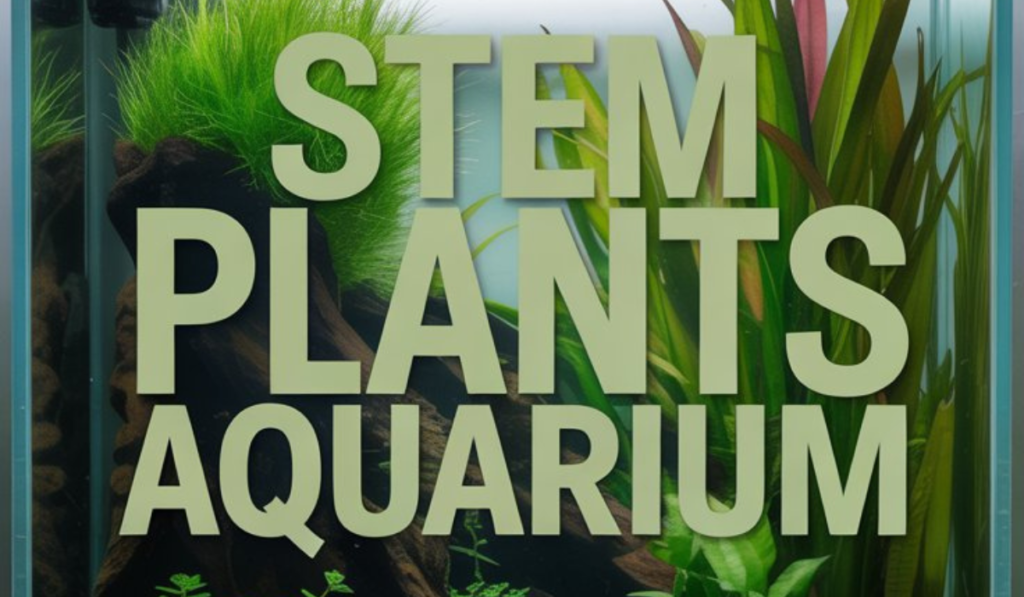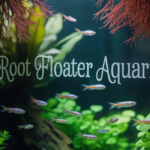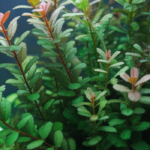Aquarium plants play a vital role in creating a healthy and visually stunning underwater ecosystem. Among the many plant types available to aquarists, stem plants are some of the most versatile, popular, and rewarding to grow. With their wide range of colors, shapes, and growth patterns, they are an essential part of aquascaping and freshwater planted tanks.
In this comprehensive guide, we’ll explore everything you need to know about stem plants in aquariums—from what they are and their benefits, to care, propagation, popular species, and tips for successful aquascaping. Whether you’re a beginner or an experienced aquarist, this article will help you understand how to use stem plants effectively in your aquarium.
What Are Stem Plants in Aquariums?
Stem plants are aquatic plants that grow vertically from a central stem, producing leaves at regular intervals. Unlike rosette plants (like swords and crypts) or floating plants, stem plants grow upwards and can quickly fill an aquarium with lush greenery.
These plants are highly diverse—ranging from delicate, feathery species to robust, broad-leaved varieties. Some species even develop vibrant red, orange, or purple hues under proper lighting and nutrients.
Stem plants can be rooted in the substrate or left floating, depending on the species and the aquarist’s design goals. Their fast growth and adaptability make them a favorite in both beginner and advanced aquascaping setups.
Benefits of Stem Plants in Aquariums
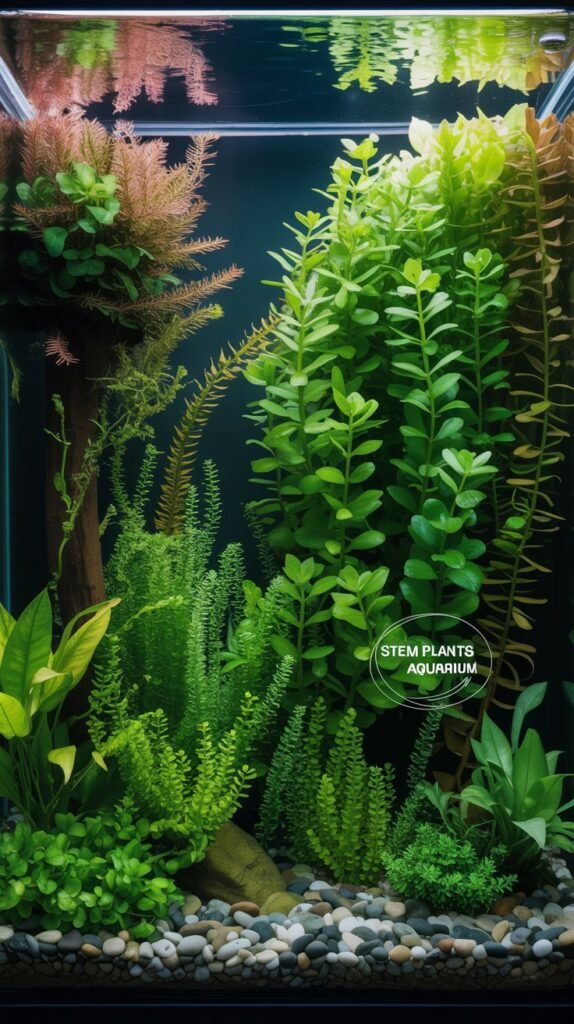
Adding stem plants to your aquarium isn’t just about aesthetics—they also provide functional benefits for your fish, water chemistry, and tank environment.
1. Oxygen Production
Like all aquatic plants, stem plants photosynthesize, releasing oxygen into the water. This helps maintain a healthy environment for fish and beneficial bacteria.
2. Nutrient Absorption
Stem plants absorb nitrates, phosphates, and other excess nutrients, reducing algae growth and maintaining water quality.
3. Habitat and Shelter
Their dense growth provides hiding places for fry, shrimp, and shy fish species. Many fish feel more secure with plant cover, reducing stress.
4. Aquascaping Flexibility
Stem plants are versatile and can be used as background, midground, or even foreground plants (depending on trimming style). They add vertical height, color contrast, and texture to aquascapes.
5. Fast Growth
Most stem plants grow quickly, making them ideal for cycling tanks and outcompeting algae.
6. Easy Propagation
They are among the easiest aquarium plants to propagate—just cut and replant the stems.
Ideal Conditions for Stem Plants
While stem plants are adaptable, they thrive under certain conditions. Providing the right environment ensures healthy growth and vibrant colors.
1. Tank Size
- Stem plants can be grown in small nano tanks or large aquariums.
- Larger tanks allow for more dramatic group plantings and varied species.
2. Lighting
- Low-light species: Hygrophila polysperma, Water wisteria.
- Medium-light species: Bacopa monnieri, Ludwigia repens.
- High-light species: Rotala wallichii, Ammannia gracilis.
- Higher light intensities bring out red, orange, and purple hues.
3. Substrate
- Nutrient-rich substrates like aqua soil or plant-specific substrates support root growth.
- Inert substrates (sand or gravel) require root tabs or liquid fertilizers.
4. CO₂ Supplementation
- Not always required, but CO₂ injection enhances growth and coloration, especially for red stem plants.
- High-demand species often require CO₂ for optimal results.
5. Water Parameters
- Temperature: 72°F – 82°F (22°C – 28°C)
- pH: 6.0 – 7.5
- Hardness: Soft to moderately hard water
6. Fertilization
- Regular dosing of macronutrients (NPK) and micronutrients (iron, magnesium, etc.) supports lush growth.
- Iron is particularly important for red coloration.
Planting and Arranging Stem Plants
Planting stem plants requires some technique to ensure they establish well and grow into attractive clusters.
Step 1: Preparation
- Trim the bottom few leaves of each stem to expose the nodes.
- Healthy nodes will sprout roots once buried.
Step 2: Planting
- Insert stems into the substrate using tweezers at a slight angle.
- Space stems at least 1–2 inches apart to prevent overcrowding.
- Plant in groups of 5–10 stems for a fuller look.
Step 3: Maintenance
- Trim regularly to encourage bushy growth.
- Replant cuttings to expand the plant cluster.
Step 4: Floating Option
- Some species can also be grown floating until roots form.
- Floating stems are useful in breeding or fry tanks.
Popular Stem Plants for Aquariums
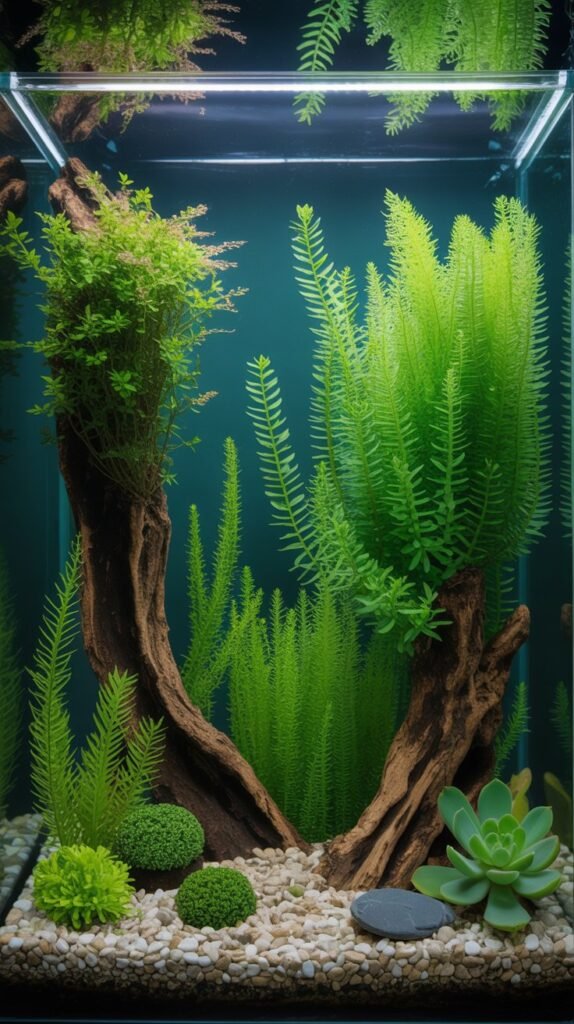
Stem plants come in many varieties. Here are some of the most common and beautiful species used in aquariums:
1. Hygrophila polysperma (Dwarf Hygro)
- Hardy and fast-growing.
- Leaves are green, sometimes with pinkish hues.
- Ideal for beginners.
2. Ludwigia repens
- Green leaves with striking red undersides.
- Easy to grow with moderate lighting.
- Provides vibrant color contrast.
3. Rotala rotundifolia
- Narrow leaves that turn red under strong light.
- Popular in aquascaping for its delicate texture.
4. Bacopa monnieri (Moneywort)
- Thick stems with round leaves.
- Slow-growing compared to other stem plants.
- Excellent for beginners.
5. Cabomba caroliniana
- Feathery, delicate foliage.
- Requires moderate to high light.
- Creates a lush, bushy background.
6. Water Wisteria (Hygrophila difformis)
- Lace-like leaves with unique shapes.
- Hardy and fast-growing.
- Can be rooted or floated.
7. Ammannia gracilis
- Vibrant red and orange coloration.
- Requires high light and CO₂.
- Best for experienced aquarists.
8. Rotala wallichii
- Fine, needle-like leaves.
- Stunning red or pink hues under strong light.
- Demanding but highly rewarding.
9. Didiplis diandra
- Compact growth with needle-like leaves.
- Needs high light and CO₂ for best results.
10. Pogostemon erectus
- Vertical, conifer-like stems.
- Creates striking contrast in aquascapes.
Aquascaping with Stem Plants
Stem plants are among the most important tools in aquascaping. They provide height, texture, and color, making them essential for well-balanced layouts.
1. Background Planting
Tall species like Ludwigia, Cabomba, and Hygrophila are excellent background plants. They create depth and cover equipment.
2. Midground Planting
Medium-sized stem plants like Bacopa and Rotala can be placed in the midground to create transitions.
3. Foreground Planting
Shorter or heavily trimmed species (like Rotala or Didiplis) can be shaped into compact foreground bushes.
4. Color Contrast
Mix green species with red/orange varieties to create striking contrasts.
5. Texture Contrast
Pair broad-leaved species with fine-leaved ones for variety.
Propagation of Stem Plants
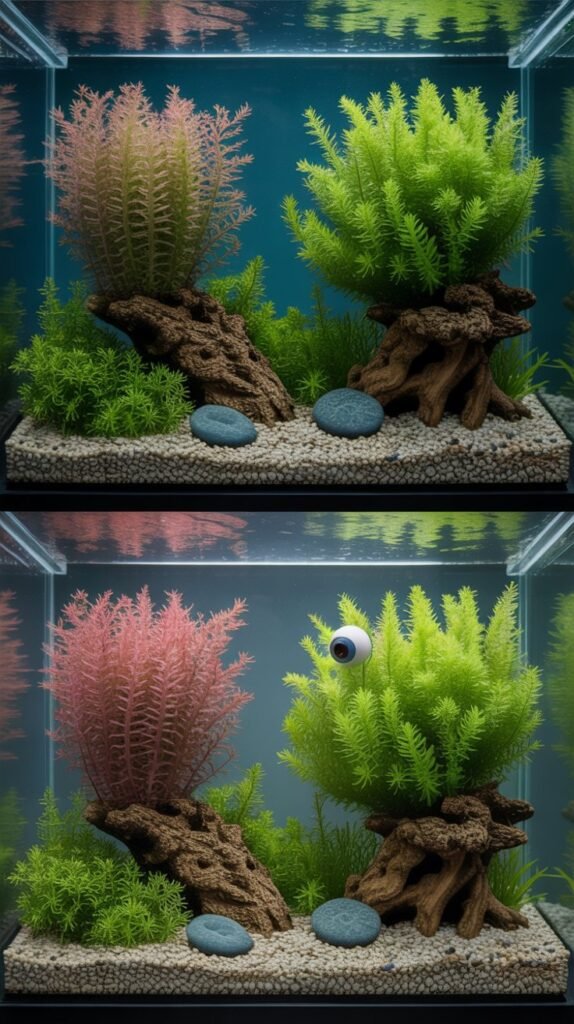
Stem plants are some of the easiest aquarium plants to propagate.
How to Propagate:
- Trim the top portion of a healthy stem.
- Remove lower leaves from the cutting.
- Replant the cutting in the substrate.
- The original stem will produce new side shoots.
This cycle allows aquarists to multiply their plants quickly and maintain a dense, bushy appearance.
Common Problems with Stem Plants and Solutions
1. Melting or Dying Leaves
- Cause: Sudden changes in water parameters.
- Solution: Allow plants to adjust gradually.
2. Algae Growth on Leaves
- Cause: Excess light, poor nutrient balance.
- Solution: Balance lighting and fertilization, add algae eaters.
3. Yellowing Leaves
- Cause: Nutrient deficiency (iron, nitrogen).
- Solution: Supplement with fertilizers.
4. Leggy Growth (Sparse Leaves)
- Cause: Low light.
- Solution: Increase lighting intensity.
5. Slow Growth
- Cause: Lack of CO₂ or poor nutrients.
- Solution: Improve fertilization and consider CO₂ injection.
Tank Mates for Stem Plants
Stem plants are compatible with most peaceful community fish and invertebrates.
Best Tank Mates:
- Tetras, Rasboras, Gouramis
- Bettas (with gentle filtration)
- Livebearers (guppies, platies, mollies)
- Shrimp and snails
Avoid:
- Goldfish (they will eat plants)
- Large cichlids (they uproot plants)
Stem Plants vs Other Plant Types
| Feature | Stem Plants | Rosette Plants (e.g., Amazon Sword) | Floating Plants (e.g., Frogbit) |
|---|---|---|---|
| Growth Style | Vertical from stem | Leaves from central rosette | Float on water surface |
| Propagation | Cuttings | Division or runners | Division of floating mats |
| Growth Rate | Fast | Moderate | Fast |
| Aquascaping Role | Background, midground | Centerpieces | Surface shade |
| Maintenance | Frequent trimming | Occasional trimming | Surface thinning |
Step-by-Step Setup: Aquarium with Stem Plants
- Choose Tank Size – 20 gallons or larger recommended for dramatic effect.
- Select Lighting – Medium to high LED lights depending on plant choice.
- Prepare Substrate – Use nutrient-rich substrate or supplement with root tabs.
- Install CO₂ (Optional) – Especially for red or demanding plants.
- Plant in Groups – 5–10 stems per cluster for fullness.
- Add Fertilizers – Dose liquid fertilizers weekly.
- Trim and Propagate – Regular trimming maintains density.
- Balance Aquascape – Mix textures and colors for natural beauty.
Tips for Thriving Stem Plants
- Plant tall species at the back and shorter ones up front for depth.
- Trim regularly to prevent overshadowing of lower plants.
- Ensure proper water circulation to deliver nutrients evenly.
- Use iron supplements to enhance red coloration.
- Avoid sudden changes in water chemistry to prevent melting.
Conclusion
Stem plants in aquariums are the backbone of many planted tank setups. Their fast growth, adaptability, and stunning variety make them indispensable for aquascaping. From beginner-friendly species like Hygrophila polysperma to challenging red varieties like Rotala wallichii, there’s a stem plant for every aquarist’s skill level.
By providing the right lighting, nutrients, and care, you can create a thriving underwater forest that not only beautifies your aquarium but also benefits your fish and water quality.
FAQs About Stem Plants Aquarium
Q1: Are stem plants good for beginners?
Yes, many stem plants like Hygrophila, Bacopa, and Water Wisteria are hardy and beginner-friendly.
Q2: Do stem plants need CO₂?
Not all, but demanding species (especially red varieties) grow best with CO₂ supplementation.
Q3: How often should I trim stem plants?
Trim every 2–3 weeks or when plants reach the water surface to encourage bushier growth.
Q4: Can stem plants grow without substrate?
Yes, some can grow floating, but rooting them in substrate ensures stability and better nutrient uptake.
Q5: Why are my stem plants turning yellow?
This is usually due to nutrient deficiencies (iron or nitrogen). Regular fertilization helps.
Q6: Can stem plants survive in low-light aquariums?
Some species like Hygrophila polysperma and Bacopa monnieri tolerate low light, but growth and color will be limited.
Q7: Do fish eat stem plants?
Most community fish don’t, but goldfish and large cichlids may nibble or uproot them.
Q8: How do I propagate stem plants?
Simply cut a healthy stem, remove lower leaves, and replant it in the substrate.
Q9: Can I mix stem plants with other plant types?
Yes! Combining stem, rosette, and floating plants creates a balanced aquascape.
Q10: Which stem plants are best for red coloration?
Rotala rotundifolia, Ludwigia repens, and Ammannia gracilis show vibrant red hues under strong light and iron supplementation.

